Liantang ancient town is located in Qingpu District with a history of more than 1000 years
Wanshan bridge: this bridge is a single span bridge
Suzhou Pingtan can be roughly divided into three schools
No.77 Qianjin Street, the former site of lujiamihang was built in 1930s
Published on 2021-04-12 13:55
Liantang ancient town is located in Qingpu District with a history of more than 1000 years. It is an ancient town hidden in the suburbs of Shanghai and the hometown of Chen Yun, an old generation proletarian revolutionist. It is located in Qingpu District in the southwest of Shanghai, adjacent to Songjiang District in the East and Jiaxing and Jiashan in Zhejiang Province in the southwest. Liantang is also a famous ancient town in the south of the Yangtze River
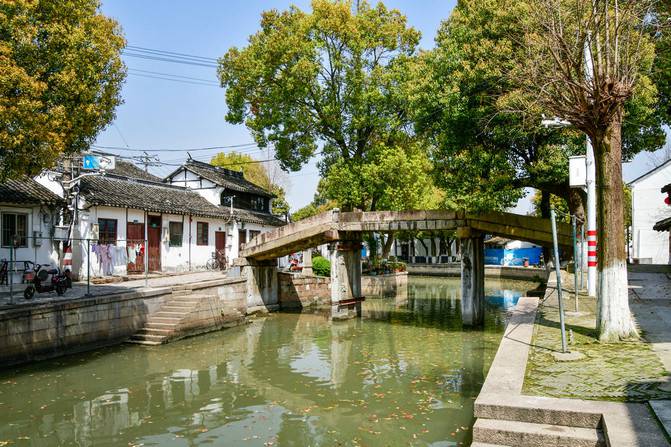
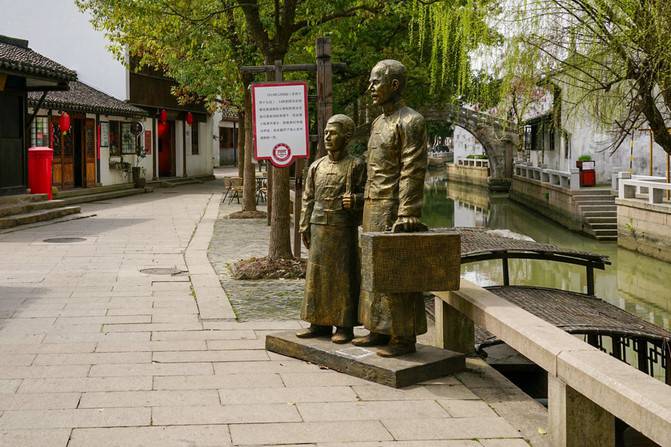
It has a history of more than 1000 years, rich in human resources and cultural relics, and has a profound cultural heritage. It is said that the Three Kingdoms and Soochow built a pond here to drill the water army, so it is named; It is also said that Zhang Zijun, the governor of Gaozhou in the Five Dynasties, and his wife, Madame Lian, once lived here.
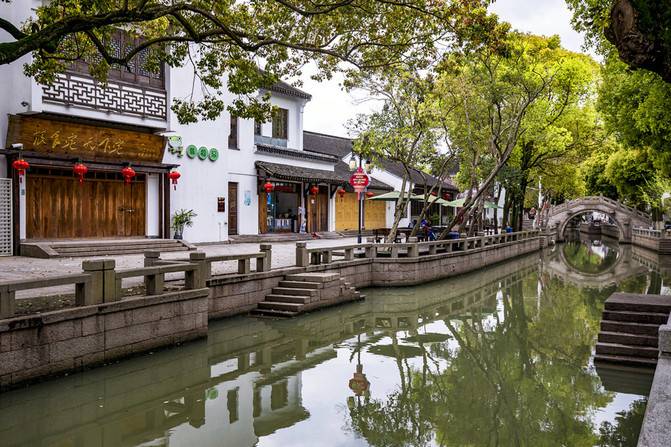
Liantang ancient town is an ancient town of indifference and life. There are no crowds of tourists and shops everywhere. There is only a river running through the ancient town, connecting more than 10 ancient bridges. The scenery is beautiful.
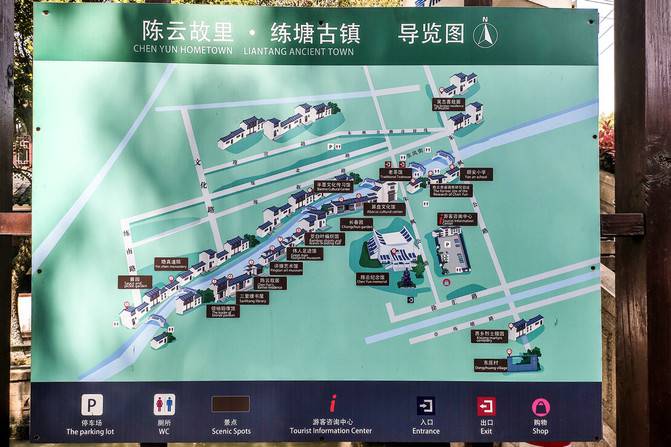
More than 10 ancient bridges of Yuan Dynasty, Ming Dynasty and Qing Dynasty across the Shihe River are hidden among the weeping willows. There are various kinds of bridges. People walk on them and flow under them. The shadows of bridges, trees, houses and people ripple in the microwave.
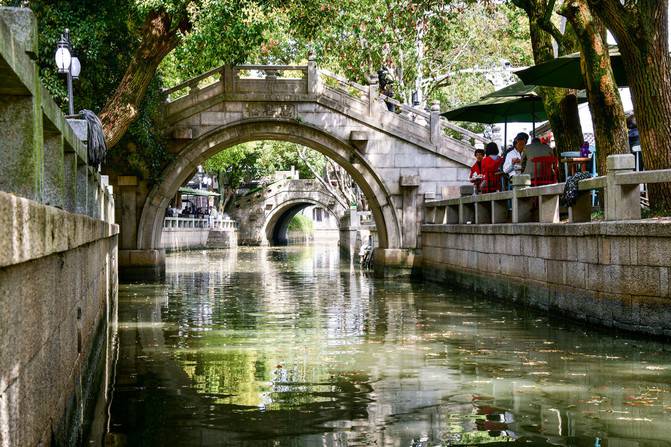
The unique landscape of Liantang is composed of "high house, narrow lane, opposite Street building, small bridge and flowing water". Liantang old street is the core of the ancient town. The old street is not long. It is only three li. A city river commonly known as "sanlitang" runs through the East and west of the ancient town. Across the river are two stone roads. One is called Shangtang Street (Dongfeng Street and Qianjin Street)
Xiatang street of Liantang is located on the South Bank of Shihe River, between youjiajing River and fengjiazha, with a total length of about 720 meters. It is one of the old streets of Liantang.
Passing through the old Zhufeng highway and heading west, Xiatang street has a "Xiatang Street noodle shop"
Outside the "noodle shop", there are open-air tables and chairs, and you can order. Tourists like to eat outside
Wanshan bridge: this bridge is a single span bridge. It also has a name of huntangbang bridge. It is a bridge built in Qing Dynasty. This bridge used to be a ring bridge. Later, it was changed into a concrete step arch bridge. Later, it was changed back to become today's stone arch bridge.
Liantang abacus culture museum is subordinate to Chen Yun Memorial Hall. This abacus museum was specially opened and built to let visitors understand the story of the great man Chen Yun. At the same time, Mr. Chen Yun, who is known as the boss of the Republic, is a real abacus master. The old man had a very profound strategy when he was in charge of the lifeline of national economic construction, Part of the root of these strategies should come from the idea of abacus.
Chen Yun, the "red shopkeeper" of the people's Republic of China
Chen Yun's "abacus classic"
Abacus culture museum shows the concept of abacus and abacus
Fat aunt's kitchen is the only barbecue shop in the ancient town of Liantang. It also sells hand-made meat dumplings and jujube palm. The old stove in the kitchen is simmering with the water town's special meat dumplings, fragrant
Zizania latifolia weaving hall is a very worthwhile scenic spot. Zizania latifolia weaving is a folk hand weaving technique which has a long history of straw weaving and willow weaving combined with the local Zizania latifolia planting industry. It has witnessed the inheritance, development and innovation of Shanghai folk arts, is the crystallization of Shanghai folk wisdom, and is a true portrayal of the development and progress of the times. Liantang is known as "the first town of Zizania latifolia in East China". Zizania latifolia is not only a table delicacy, but also can be woven into exquisite handicrafts. Walking into the experience hall, you can not only enjoy the exquisite weaving skills, but also experience the fun of weaving with your own hands.
Chen Yun's former residence, No.95 Xiatang street, is an old-fashioned brick and wood Jiangnan residence with a total construction area of 95.88 square meters. The front part of the former residence is the storefront, which was used by Chen Yun's uncle as a tailor shop and a small hotel to make a living. Behind the store is a two-story building. The upstairs is the bedroom of Uncle Chen Yun's parents, and the downstairs is the room where Chen Yun once lived. The furnishings in his former residence basically keep the original appearance of that year. Chen Yun lived in his uncle's and aunt's house for 8 years (6-14 years old), and then went to Shanghai Commercial Press as an apprentice.
Sanshengtang bookstore, No. 100 Xiatang street, opened the first bookstore in Liantang Town at the end of Qing Dynasty, named "Changyuan". The residents of the town like to listen to Pingtan, and the business of Changyuan is booming. As a result, another Bookstore named "Changqingyuan" also appeared in huntangbang, singing "antithetical drama" with "Changyuan".
"Pingtan Art Museum", Liantang Town Government used a house in Xiatang street to set up Pingtan Culture Museum. It's not expensive, but it's unique. In the final analysis, the Pingtan Art Museum has a lot to do with Chen Yun.
Chen Yun, born in the south of the Yangtze River, loved Pingtan all his life. When he was a poor boy, he could only stand in the corner of the bookstore and listen to it. In the 1950s, during his investigation and research in Jiangsu, Zhejiang and Shanghai, he used his rest time to make up for his childhood regret. He also began to record the singing clips of famous Pingtan artists, saved a lot of precious Pingtan materials, and established Suzhou Pingtan School under his initiative, so that this colorful folk art has been carried forward in the land suitable for her.
Suzhou Pingtan can be roughly divided into three schools, namely Chen Diao, Ma Diao and Yu Diao.
Chen Yuqian, the founder of Chen Diao, was born in Suzhou. He was a Tanci artist in Suzhou during the reign of Qianlong and Jiaqing in Qing Dynasty. In his early years, he sang Suzhou Kunqu Opera. Later, he changed to Tanci and used a voice similar to Kunqu Opera. He mainly sings in a loud voice, with a broad and vigorous voice, sometimes mixed with a low voice, which increases the sense of twists and turns and sadness
Ma Diao was founded by Xianfeng of Qing Dynasty and Ma Rufei, an artist in Tongzhi. Singing is gradually formed on the basis of Shu Diao, and deeply influenced by Dongxiang Diao. It focuses on recitation, emphasizes the language factors of lyrics, and has a flat melody. But every word has its own sound, sonorous and powerful, strong narrative. According to the rules of seven character libretto, the sixth character of the next sentence is often punctuated to highlight the rhyme. Singing not only attaches importance to language factors, but also has strong plasticity.
Based on "Ma Diao", the developed schools of singing include "Wei Diao", "Shen Diao", "Xue Diao" and "Qin Diao" in modern times. Their common characteristics are lively rhythm, paying attention to aura, and are generally good at duanchang and Lianyun reduplication.
Wu Kaixian's former residence, Wu Kaixian's former residence, "Wu Kaixian's former residence" is listed as "Qingpu District cultural relics protection point": it was announced in February 2017, and now is: leader bronze Museum,
"The leader's bronze statue museum is located in Xiatang street, with brick and wood structure. The architectural design not only reflects the characteristics of Jiangnan, but also keeps consistent and harmonious with the style of Chen Yun's former residence and the surrounding folk architecture. The bronze statues of six great men and ten marshals standing in the Museum give people a new taste of the leader's style.
The exhibition hall is reconstructed from the original Yulan residence of the memorial hall. It has three courtyards and is a two-story single family building. More than 60 bronze statues of leaders are displayed in the hall by the famous sculptor and calligrapher Mr. Cheng Yunxian.
The first thing I saw in the front room was a bronze statue of the head of Marx, Engels, Lenin and Mao Zedong. I wondered why there was no Stalin.
Bronze statue of leader
Young Deng Xiaoping stood in front of the open-air central hall
Mao Zedong, Zhu De and Zhou Enlai were first seen in the room.
There are no pictures of marshals and Chen Yun.
On the right is Chen Yun
Climbing up the second floor along the narrow old stairs, it's very quiet. A magnolia is the oldest and the only famous ancient tree in Shanghai that has been listed as the second class national protection. It has a history of more than 100 years. The tree is 8.7 meters high, 0.23 meters in diameter at breast height and 6 meters in crown width. When the flowers bloom in early spring, more than 3000 white flowers rush to bloom, just like jade butterflies gathering in the distance, looking at the clouds. The fragrance is old and intoxicating. It is a major landscape in the ancient town and a witness of history. It is a living cultural relic and a rare treasure.
This Magnolia grandiflora is the oldest Magnolia grandiflora in Shanghai. Because Magnolia grandiflora is the city flower of Shanghai, it is also the oldest city flower in Shanghai, followed by Wu Kaixian's own planting, so it is rated as "famous tree". In Shanghai, there are only 34 famous trees. It is listed in No. 0660 of "ancient and famous trees protection card" and is a famous tree (confirmed in December 2002), with first-class protection
The second floor mainly displays oil paintings and other paintings.
The portraits of Chen Yun and the leaders first came into view
Chen Yun on the Great Wall
President Xi's military parade
There are many images of revolutionary soldiers fighting in the room. It's so heroic, it's so powerful.
Chaozhen bridge is commonly known as Shengtang bridge because it is in front of Shengtang. It is a single hole stone arch bridge with a north-south trend. It was rebuilt in 1555 (the 34th year of Jiajing in Ming Dynasty) and rebuilt in 1695 (the 34th year of Kangxi in Qing Dynasty).
Bluestone and granite are mixed, and the arch is built by longitudinal joint and segmental masonry. The bridge is 18 meters long, 3.5 meters wide, with an arch span of 6.8 meters and an arch height of 3.7 meters. There are 25 vertical steps on the south slope, 15 vertical steps on the north slope and 10 vertical steps on the lower slope. Most of the railings are new, with the Ming Dynasty original in the middle. In May 2001, it was announced as a cultural relic protection unit in Qingpu District. There is an ancient pomegranate on the east side of NaNTU bridge, which has abundant branches and luxuriant leaves. It is a century old confidant of the ancient bridge.
Description of Chaozhen Bridge
The north side of the bridge is opposite to the former temple, which is now separated by the screen wall. Although Zhaobi is newly built, the brick carvings on the wall, such as "tower yard dawn bell" and "Jiangnan Water Town Liantang", have exquisite pictures and exquisite carvings. Among them, "tower yard dawn bell" is engraved with a poem: see the floating picture in the distant view of the ring bridge, and ask Jun Tu in the vast misty waves; Do you know that Leifeng is standing at the same time, Xiaozhong is suspected to be Mengxi lake.
Shengtang was originally Yinzhen Taoist temple in Song Dynasty. It was rebuilt in 1814 and changed its name to Shengtang. The original three into, now one into. Building area of 110 square meters, south facing, brick and wood structure. Three Bay, 11.2 meters wide, seven beams, 8.3 meters deep, front eaves with corridors, 1.6 meters wide, curved rafters, cornices with wood carving, hard Hill tile roof, surrounded by walls, wall doors, standing on both sides of a pair of bluestone drum.
Reconstruction of Chaozhen Bridge
Stone inscription "Fa Zhang Lian Tang Tongren Tang edict tablet": FA Zhang Lian Tang is the ancient name of Lian Tang. The stone tablet erected in 1814, the 19th year of Jiaqing reign of the Qing Dynasty, is equivalent to the present document of "notice to all Tongren hall in Liantang".
Zhonghong bridge, also known as Zhongmu bridge, is a stone arch bridge with a single hole. It used to be a wooden bridge, but it was not rebuilt as a stone arch bridge until 2000. So this bridge is not an ancient one.
Shunde bridge is located in the West tip of Liantang, Shanghai. It was built between Yuan Dynasty and Zhengjian (1341-1368). It was rebuilt three times in shunzhijian (1644-1661), the 58th year of Kangxi (1719) and the 49th year of Qianlong (1784). The bridge is 16.4 meters long, 2.3 meters wide and 4.1 meters high. There are couplets on the bridge: "Jiufeng is an important town, Taoyuan starts early, Hedang sings fishing songs late, and Sanmao sails.". The couplets depict the beautiful scenery of Liantang Town, among which "nine peaks row green, three Maos row sails, and crane Dang fishing songs" all rank among the eight sceneries of Liantang. In 1959, it was listed as a cultural relic protection unit at the county level. Since then, it has been repaired and reinforced for many times. So that the whole style of the bridge is intact, the pattern carving is prominent, the form is simple, but it is powerful and magnificent.
Shunde bridge seems to be full of vicissitudes. The stone slabs on the bridge level look very mottled. It can be imagined how the ancient bridge, which has gone through more than 1000 dynasties, has provided convenience for the ancestors of Qingpu. It is the oldest bridge in Liantang Town, ranking first among the eight bridges,
There are 3 spans in total, the middle span is the channel, the bridge railing and bridge deck are granite long stones, the bridge columns are blue stones, long strips, 3 blocks in the north and 3 blocks in the south, of which the hole is connected to the ship, and the side hole is used to discharge water. Juxtaposed into stone wall type, simple structure, for a beam column type stone bridge, with typical characteristics of the Yuan Dynasty, has been rare in Shanghai, in Jinze Town, there is a similar shape and age Yingxiang bridge, these two bridges are later known as sister bridge.
Now we can see the original appearance of the bridge deck in the 49th year of Emperor Qianlong. The beams are engraved with "Shunde bridge" and "reconstruction of Shunde bridge" respectively. There is no other chronology. Liang Duan has coins and Ruyi patterns.
Liantang Qianjin Street is located on the North Bank of Shihe River, from the old Zhufeng highway to the West tip of the ancient town, with a total length of about 650 meters. It is one of the old Liantang streets.
No.77 Qianjin Street, the former site of lujiamihang was built in 1930s. It covers an area of 175 square meters, with a construction area of 188 square meters. It is surrounded by high walls, Shikumen, and brick carving gate. The main house has a two-story brick and wood structure, with a width of 11.2 meters, a nine storey beam, a depth of 9.8 meters, and a seven storey beam, a depth of 8.1 meters, In 2004, it was announced as a registered immovable cultural relic in the district.
In terms of appearance, there are homes on the ground floor of the former lujiamihang site,
Authentic old buildings
New bridge, Qianjin bridge, cross the bridge to Shangtang Street (Qianjin Street)
The Western District Fire Club is a fire club in the period of the Republic of China.
Located at 138 Qianjin Street, Liantang Town, Fukang soy sauce garden is a courtyard style building. It was founded in 1919 and is famous for its wine, sauce, malt sugar and pickles.
Soy sauce garden is a typical layout of front shop and back workshop. In front of Shikumen, there is a sales department. In the back, there are workshops for liquor making, sauce making, malt sugar and pickle processing. Due to its proper operation, the store opened two branches in the town, East and West, with more than 100 employees. A large number of products are sold to Shanghai and its surrounding areas. It's the biggest shop in Liantang Town.
The soy sauce garden faces south with brick and wood structure. The green brick exterior wall is 10 meters high. There are two big characters of red "soy sauce garden" on the wall, the inscription of "Fukang brand" on the forehead, and the stone slab wall protection on both sides of the wall is exquisite. The eaves are decorated with bricks. The wooden door, 0.99M wide and 2.98M high, is inlaid with 353 copper foam nails. The main house has two floors, three bays, nine beams, depth of 10.1 meters, double eaves, eaves with wood carving, hard peak, small tile roof. In 2017, it was announced as a cultural relic protection site in Qingpu District
Published in February 2017.
No. 126 Qianjin Street, Xiwang Tongxing salty goods store, was the largest store in Liantang Town during the period of Fukang soy sauce garden in the Republic of China. It was built in 1919. It is a unique Shikumen building in the early Republic of China. It is a typical layout of front store and back workshop. Inside Shikumen is a marketing department, behind which there are workshops for liquor making, sauce making, malt sugar and pickle processing. Among them, "three white" (white water, white rice and white flour) is used for liquor making, which tastes sweet and has clear color. After the completion of the store, due to its proper operation, it opened two branches in the town, East and West, with more than 100 employees. A large number of products are sold to Shanghai and surrounding areas.
"Xiwang Tongxing salty goods store" is listed as "Qingpu District cultural relics protection point": it is said that this is xihengfengxiang south goods store founded by Gao's family (the father of gorsong and gorbo) in 1928. Gao Ersong (1900-1986, word Jiying, pen name Gao Xisheng, member of China Democratic League) and Gao Erbai (1901-1986, word Yongwei, pen name Guo Zhen, member of China Democratic Promotion Association) Kun Zhong, studied in Yan'an primary school when they were young. They were one of the earliest revolutionaries in Qingpu and also the earliest Communist Party members in Qingpu.
Gao's house was originally founded by Gao Ersong and Gao Erpai's father as "Xiwang Tongxing salt store".
At first, the Gao family lived in Zhendong. In 1907, his father set up Hengfeng Xiangnan goods store in the town, so the whole family moved, and the two brothers had the opportunity to study in Yan'an primary school. Now: Southern store
Published in February 2017“ Gao's residence has been listed as a cultural relic protection site in Qingpu District
Qianjin Street, double bridge, Wanshan bridge and Liufang Bridge
Liantang old bowl shop is located at 133 Dongfeng Street, next to Liufang bridge. It mainly sells old bowls, supplemented by a variety of groceries. The owner is an old couple. There are all kinds of blue and white bowls and Lingling bowls produced in Jingdezhen in the 1950s and 1960s, as well as household goods in the 1930s. It has a great sense of the times.
Liufang bridge: it was built as a stone bridge in 1857. In 1973, Zhufeng highway was built and replaced with concrete slab girder bridge. In April 2000, double stone arch bridges were built on both sides.
Behind the bridge is the old Zhufeng highway. Dongfeng Street and Changchun Street are in the East, and Qianjin Road and Qianjin Street are in the West. It is an important traffic road.
Liufang bridge at Dongfeng Street
Liantang Dongfeng Street, located on the North Bank of Shihe River and between youjiajing River and laozhufeng highway, has a total length of about 320 meters. It is one of the old streets of Liantang.
The folk houses on Dongfeng Street inhabit the river.
Trestle bridge: this bridge is also called Dongmu bridge. It was originally a single hole beam bridge with stone piers and wooden surfaces. Later generations used stone platforms and stone steps to rebuild it into a cement flat bridge.
Yixue bridge, commonly known as huishi'an bridge, is located in the East head of Liantang ancient town (No. 12, Dongfeng Street, Dongtu, No. 5, Xiatang street, NaNTU), a single hole stone arch bridge with north-south direction. In May 2001, it was announced as a cultural relic protection unit in Qingpu District.
The bridge was first built in the reign of Tianqi in the Ming Dynasty and rebuilt in the 17th year of Daoguang in the Qing Dynasty (1837). The bridge is 16.4m long, 3M wide, 4.2m high, with arch span of 5.7m and arch height of 3.1m. There are 18 steps on the south slope, 3 steps on the bottom and 22 steps on the north slope. The fence is new. There are bridges on both sides. Donglian: May heaven always give birth to good people; May people always do good things. Western Union: the moon shines on the West River, the green lotus lies drunk; Sima of hongsuo East Village left a topic. The forehead of the bridge is engraved with "the 17th year of Daoguang" and "rebuilding Yixue bridge".
There are four lions on the bridge. The strange thing is that the steps on both sides are different. There are 22 steps in the north and 18 steps in the south.
The former sites of "Qingpu County Public Security Bureau No.2" and "Eastern District Fire Club" are located in Dongfeng Street, Qiaobei;
The Eastern District Fire Club is located at 11-12 Dongfeng Street, Xiatang Street neighborhood committee. According to historical data: Liantang East fire club was the former site of Huishi nunnery. During the period of the Republic of China, it was changed to Liantang East fire club.
After liberation, it was the second branch of Qingpu County Public Security Bureau, and the rich carving and writing on the facade of the building were still intact. In February 2017, the "Eastern District Fire Club" was listed as "Qingpu District cultural relics protection point".
Xiatang street in the south of the bridge is the former site of Yan'an primary school, where Comrade Chen Yun studied. The current name of the university is also the subject of Comrade Chen Yun.
Yan'an primary school, formerly known as Yan'an academy, was founded in the 15th year of the reign of Emperor Guangxu of the Qing Dynasty. In the 31st year, it was renamed Yan'an junior primary school. In the first year of the Republic of China (1912), it was renamed Yan'an National Primary School. After liberation, it was renamed Liantang Town primary school. A group of celebrities in Liantang, such as Wu Kaixian, Wu Zhixi, Gao Ersong, Gao Erbai, Yuan Wenbin, and proletarian revolutionary comrade Chen Yun, all received education in Yan'an elementary school. After graduating from the school in the autumn of 1919, Comrade Chen Yun went to work in Shanghai Commercial Press. In September 1986, Comrade Chen Yun wrote the name of his alma mater. Yan'an primary school still retains the pattern of academies in Chen Yun's early years.
There is a building under repair on Xiatang street in the south of the bridge. It seems that there is a story
In ancient times, there were many taboos and worships. One of them was "Taishan shigandang". The stele engraved with Taishan shigandang (three feet and three inches high) was erected at the main point of the bridge or on the wall of the house, which could suppress all the ominous evils. It was very popular among the people. In June 2006, it was listed in the first batch of national intangible cultural heritage list.
Xiatang Street corridor of Liantang ancient town, cultural relics protection site of Qingpu District
The gallery shed is the gallery shed of the water transport wharf in Liantang Town in the Qing Dynasty. It is located on the West Bank of Lihua port, which can prove the busy scene of water transport in Liantang Town at that time.
Chenyun Qingpu rural survey old house, located at 25 Xiatang street, facing north from south, is a two-story, three Bay, brick and wood structure building. At present, the middle of the ground floor is the guest hall, and the East and West Wing rooms are equipped with a special exhibition "Chen Yun and Qingpu rural survey". During the period when Comrade Chen Yun presided over the national financial and economic work, in order to make the central government's policies conform to the national conditions and the public opinion, he went back to his hometown for four times from January 1955 to July 1961. On the basis of listening to the voice of the people, understanding the public opinion and grasping the truth, he put forward a series of opinions in line with the truth and made indelible contributions to the steady and healthy development of the national economy.
,
Lingen hall, No.5, Lane 37, Xiatang street. In 1883, Christianity was introduced into Qingpu by American missionary Li Silun and Liantang by Pastor Dai Yangqing. At that time, there was still a "huntangbang church" in Liantang Town. Lingen church was built in 1903. In 1910, it was expanded. In 1986, the religious policy was implemented, some houses were returned, and the hall resumed its activities, which was once called "Liantang gathering place". The former Methodist Church and the Apostolic Faith Church established a joint Hall, which was restored on October 21. In 1988, it was renamed Liantang Lingen hall.
Yongxing bridge is located at 42 Xiatang old street, Liantang Town. Yongxing bridge is the only East-West bridge in the four bridges of Liantang. The river it crosses is lihuagang bridge, which is commonly known as lihuagang bridge by local people.
Single hole stone arch bridge. It's also a real ancient bridge. It's amazing.
It was built in the Ming Dynasty and rebuilt in 1776. The bridge is 18.3 meters long, 2.1 meters wide, 4 meters high, with an arch span of 6.1 meters and an arch height of 3.4 meters. There are 23 and 22 steps on the East and West slopes respectively, and the bluestone long strip stone fence is a new one. There is a couplet on each side. On the bridge forehead is the year of "rebuilding Yongxing bridge, Qianlong bingshen".
No. 19-33, Lane 44, Xiatang street, Xiatang Street neighborhood committee, Liantang Town; No. 56, Xiatang Street neighborhood committee, Liantang Town; No. 57, Xiatang street, Liantang Town
Liantang Art Museum, the door is closed, can't enter to visit.
Antithetical couplet of the gate: the golden sword is crowned with the square Confucian, and the jade pen is startled by the wind and rain
This is the end of the tour to Liantang ancient town
Leave a Comment